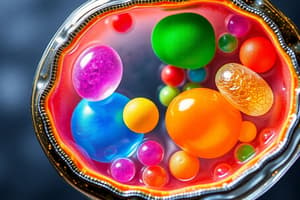Podcast
Questions and Answers
What is a cell?
What is a cell?
- Collection of living matter enclosed by a barrier (correct)
- Structure that contains genetic material
- A group of similar cells
- Small particle involved in protein synthesis
What does cell theory state?
What does cell theory state?
All living things are composed of cells; cells are the basic unit of structure and function in living things; new cells are produced from existing cells.
What is the function of the nucleus?
What is the function of the nucleus?
- Assists in cell division
- Stores nutrients
- Controls the cell's activities (correct)
- Produces energy
Eukaryotes do not contain nuclei.
Eukaryotes do not contain nuclei.
Prokaryotes contain nuclei.
Prokaryotes contain nuclei.
What are organelles?
What are organelles?
What is cytoplasm?
What is cytoplasm?
What is the nuclear envelope?
What is the nuclear envelope?
What is chromatin?
What is chromatin?
What are ribosomes responsible for?
What are ribosomes responsible for?
What does the Golgi apparatus do?
What does the Golgi apparatus do?
What are lysosomes?
What are lysosomes?
What is the function of mitochondria?
What is the function of mitochondria?
What do chloroplasts do?
What do chloroplasts do?
What is the cytoskeleton?
What is the cytoskeleton?
What is diffusion?
What is diffusion?
What is osmosis?
What is osmosis?
What is the meaning of isotonic?
What is the meaning of isotonic?
What is active transport?
What is active transport?
What is cell specialization?
What is cell specialization?
What are the levels of organization in a multicellular organism?
What are the levels of organization in a multicellular organism?
What is a tissue?
What is a tissue?
What is an organ?
What is an organ?
What is an organ system?
What is an organ system?
Flashcards are hidden until you start studying
Study Notes
Cell Structure and Function
- A cell is the fundamental unit of life, composed of living matter enclosed by a membrane.
- Cell theory posits that all living organisms consist of cells, which are the basic structural and functional units, and new cells arise from existing ones.
Cell Nucleus and Genetic Material
- The nucleus contains genetic material (DNA) and directs cell activities.
- Eukaryotes are cells with a nucleus, while prokaryotes lack a nucleus.
- Chromatin is made of DNA and proteins, and it condenses to form chromosomes, which carry genetic information.
Organelles and Cellular Functions
- Organelles are specialized structures within a cell, akin to tiny organs with specific functions.
- The nucleolus within the nucleus is where ribosomes are synthesized.
- Ribosomes are responsible for protein assembly and are found throughout the cytoplasm.
Endoplasmic Reticulum and Golgi Apparatus
- The endoplasmic reticulum (ER) is an internal membrane system; it includes:
- Rough ER, studded with ribosomes, synthesizes proteins.
- Smooth ER, devoid of ribosomes, synthesizes lipids and detoxifies drugs.
- The Golgi apparatus modifies, sorts, and packages proteins and materials for storage or export.
Lysosomes and Vacuoles
- Lysosomes are organelles filled with enzymes that digest macromolecules and recycle cellular components.
- Vacuoles are saclike structures for storing materials such as water, salts, and nutrients.
Energy-Converting Organelles
- Mitochondria convert chemical energy from food into usable energy for the cell.
- Chloroplasts capture solar energy and undergo photosynthesis to convert it into chemical energy.
Cytoskeleton and Cell Shape
- The cytoskeleton is a protein filament network that maintains cell shape and aids in movement.
- Microfilaments are flexible structures made of actin; they form supportive networks.
- Microtubules are hollow tubes of tubulin that play roles in cell structure and division.
Centrioles and Cell Membrane
- Centrioles organize cell division and are absent in plant cells.
- The cell membrane is a flexible barrier that regulates entry and exit of substances and provides support.
Transport Mechanisms
- Concentration refers to the mass of solute in a solution.
- Diffusion involves movement from high to low concentration without energy.
- Osmosis is the diffusion of water across a selectively permeable membrane.
- Isotonic, hypertonic, and hypotonic describe different concentrations of solute relative to another solution.
- Facilitated diffusion utilizes protein channels for substance transport.
- Active transport requires energy input to move substances against their concentration gradient.
Endocytosis and Exocytosis
- Endocytosis is the process of bringing materials into the cell via membrane pockets.
- Phagocytosis and pinocytosis are forms of endocytosis for solids and liquids, respectively.
- Exocytosis expels materials from the cell by merging vacuole membranes with the cell membrane.
Cell Specialization and Organization
- Cell specialization allows different cell types to perform unique functions in multicellular organisms.
- Multicellular organization includes levels such as cells, tissues, organs, and organ systems.
- A tissue comprises similar cells executing a specific function.
- An organ is formed from multiple tissue types working together.
- An organ system consists of a group of organs collaborating to perform a particular role.
Studying That Suits You
Use AI to generate personalized quizzes and flashcards to suit your learning preferences.




